#la tavola ritonda
Text
La Tavola Ritonda PDF is now available to read! Enjoy!

ID: When Isotta had returned to the pavilion, the tables were set out and food was prepared, and when water had been brought for their hands they sat down to eat. As they ate, Gariette looked out and saw Palamidesso going by looking for them, and pointed him out to Sir Tristano. Tristano got up and went to meet him, taking him by the hand and leading him into the pavilion, where he disarmed and sat at the table. They all passed that night in great joy.
Medieval Literature scans | Arthurian Retellings scans | Ko-fi
⤥Italian Name Guide Below Cut
Prose Tristan Gang
King Meliadus of Liones (Meliodas of Lyonesse)
Queen Eliabella (Elizabeth)
Tristano (Tristan)
King Marco of Cornovaglia/Tintoile (Mark of Cornwall/Tintagel)
King Amoroldo of Irlanda (Morholt of Ireland)
King Languis of Irlanda (Anguish of Ireland)
Queen Isotta the Blonde (Isolde 1)
Gouvernale (Governal)
Brandina (Brangaine)
Dinadano (Dinadan)
Daniello (Daniel)
Brunoro the Black/Ill-Cut Coat (Brunor le Noir/La Cote Male Taile)
Dinasso the Seneschal (Dinas)
King Scalabrino (Esclabor)
Palamidesso the Pagan (Palomides/Palamedes)
Isotta White Hands (Isolde 2)
Gheddino (Kahedrin)
Logres
King Artù of Camellotto/Longres (Arthur of Camelot/Logres)
Queen Ginevara (Guinevere)
Chieso the Seneschal (Kay)
Lucano (Lucan)
Fata Morgana (Morgan le Fay)
Pulzella Gais (Morgan's daughter)
Merlino the Prophet (Merlin)
Orcadians
King Lotto (Lot)
Queen Albagia of Organia (Morgause of Orkney)
Calvano the Lover (Gawain)
Agravano (Agravaine)
Gariens (Gaheris)
Gariette (Gareth)
Mordarette (Mordred)
Welsh
King Pellinoro of Gaules (Pellinore of Wales)
Prezzivale lo Galese (Percival of Wales)
Amorotto di Gaules (Lamorak of Wales)
Adriano (Drian)
Agravale (Aglovale)
French
King Bando of Benoich (Ban of Benwick)
Dama del Lago (Lady of the Lake)
Lancilotto of Gioisa Guardia (Lancelot of Joyous Guard)
Astore di Mare (Hector de Maris)
Lionello (Lionel)
Bordo (Bors)
Briobris (Biloberis)
Galasso (Galahad)
Others
Brunoro the Brown (Brunor father of Galehaut)
Bagotta (Fair Giantess)
Galeotto (Galehaut)
Sagramore (Sagramore lol)
Meliagans (Meleagant/Melwas)
King Brando of Magus (Bademagus)
Beast Glatisanti (Questing Beast/Glatisants)
#arthurian legend#arthurian legends#arthuriana#arthurian mythology#arthurian literature#prose tristan#la tavola ritonda#tristan and the round table#arthurian preservation project#tristan and isolde#tristan and iseult#sir tristan#isolde#iseult#palamedes#palomides#sir palamedes#sir palomides#dinadan#sir dinadan#lamorak#sir lamorak#scans by L#my post
82 notes
·
View notes
Text
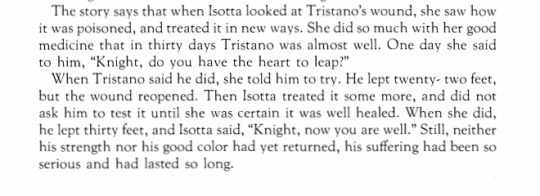
...Tristan knows the Salmon Leap™ can JUMP
(Source: La Tavola Ritona)
#tristan can JUMP#sir tristan#isolde#tristan and isolde#la tavola ritonda#arthuriana#arthurian legend#arthurian mythology#arthurian legends#celtic myth
6 notes
·
View notes
Note
I wanna start reading Arthurian…..where should I begin
*rubs hands* oh excellent
I'd say one way would be to pick characters or events you'd like to read about the most and start with the texts focusing on them. @fuckyeaharthuriana has a lot of lists of different works, including those sorted by character (links in the blog description). Then, if you decide you enjoy Arthuriana in general, you can move to other texts. Another way would be to start with something well-known and short. I believe Sir Gawain and the Green Knight fits the bill well. The translation linked is more like an example, because there's a lot of them, and I frankly don't know which to suggest best; the one I read is by Bernard O’Donoghue, but I can't find it online. I've also heard very good things about Tolkien's translation - understandable, because duh, Tolkien - but haven't read it (yet). The works of Chrétien de Troyes are also very good and readable and imo very well represent what a medieval romance is. My favourite is Yvain: Knight of the Lion, and I haven't read his Perceval yet, but I liked all the other of his romances too. (Ok, maybe not Erec and Enide, but that's because I found the main character very annoying)
I've compiled a small list of Arthurian texts I recommend before when answering a similar ask, and I still stand by it, except, taking into account what I've read since then, I'd also add La Tavola Ritonda - an Italian Arthurian romance mostly focused on Tristan and Isolde, weird and violent but also very enjoyable, in my opinion, Parzival (vol. 1, vol. 2) by Wolfram Von Eschenbach - a German romance and my favourite version of the Grail story so far, and Lancelot-Grail aka the Vulgate Cycle + the Post-Vulgate. I'm not sure starting with the latter is a good idea, though, because it's five huge volumes, very readable (except for The History of the Holy Grail. You can skip that, if you ask me) and with a great impact on the later Arthurian texts, including Le Morte d'Arthur, but HUGE, it took me half a year, lol. (Le Morte is also long and often drier in style, but still not THAT long). But I simply had to mention it because it's such a foundational work. A part of the Vulgate Cycle has been adapted by Patricia Terry and Samuel N. Rosenberg as Lancelot and the Lord of the Distant Isles or, The Book of Galehaut Retold. It's short and beautiful, and you don't need to be familiar with the rest of the Vulgate to read it.
Oh, and if you're interested in more modern retellings, Idylls of the Queen by Phyllis Ann Karr is an episode from Le Morte d'Arthur retold as a murder mystery solved by Kay and Mordred, and it's amazing. Also The Squire's Tales series by Gerald Morris is a lot of fun, kind of for a younger reader but very well-written and funny, even though some of his choices regarding certain characters drive me up the wall a little bit.
Also, here's a great site by @tillman with a lot of links to various Arthurian texts!
#this is very chaotic i'm sorry#asks#kitsnicket#arthurian legends#arthuriana#gella talks arthuriana#talk talk talk
68 notes
·
View notes
Note
who's galehaut
Galehaut
Article Talk
Language
Watch
Edit
Galehaut (or Galaha[l/u]t, Galeho[l]t, Gallehau[l]t, Galhault, Galetto, et al.) is a half-giant knight in the Arthurian legend. He is most prominent within the Lancelot-Grail prose cycle where he is a noble enemy turned an ally of King Arthur as well as an inseparable friend (and possible lover, according to some interpretations of the early 13th-century "Lancelot propre", from the Vulgate Cycle[1]) of Arthur's champion Lancelot. The figure of Galehaut should not be mistaken with Lancelot's son, Galahad (which is also Lancelot's own birth name), and some other similarly named characters.
Galehaut's attributed arms
Legend
Edit
Galehaut, lord of the Distant Isles (le sire des Isles Lointaines),[2] appears for the first time in the Matter of Britain in the "Book of Galehaut" section of the early 13th-century Prose Lancelot Proper, the central work in the series of anonymous Old French prose romances collectively known as Lancelot-Grail (the Vulgate Cycle). An ambitious, towering figure of a man, he emerges from obscurity to challenge King Arthur for possession of Arthur's realm of Logres. Though unknown to Arthur and his court, Galehaut has already conquered lands and acquired considerable power, loyal followers, and a reputation for being a noble character. The Vulgate Cycle and the Prose Tristan describe him as "the son of the Fair Giantess" (fils de la Bele Jaiande), given the name Bagotta in La Tavola Ritonda,[3] and the evil human lord Brunor, both of whom are later killed by Tristan who takes over their castle. Galehaut also has a sister, named Delice in the Prose Tristan and Riccarda in the Italian version I Due Tristani.[4]
'Lacelot', 'Gallehault', and Guinevere: "How the first acquaintance was made with Galhault by the Lady of Logres." Lancelot en prose, c. 1494
In the ensuing war, it becomes clear that Galehaut's army is going to win against Arthur's. However, Galehaut is so awed by the battlefield prowess of one of Arthur's knights, the mysterious Black Knight, that for his sake he renounces a certain victory and surrenders to Arthur. The knight, who turns out to be the young Lancelot, gratefully accepts Galehaut's companionship. What follows is a tale of love, interpreted by some scholars as friendship[5] and by many as homosexuality,[6][7][8][9][5] in which Galehaut figures as the central character as he becomes the tragic hero in the story. Galehaut, just as he has surrendered to Arthur, gives way before Guinevere, yielding Lancelot to her. He also joins Arthur's Knights of the Round Table, and later gives refuge to Lancelot and Guinevere in his land of Sorelois during the False Guinevere episode. He ultimately dies by longing for Lancelot, having been separated with him (Lancelot was first kidnapped by Morgan le Fay and then went mad and disappeared) and after receiving false news of his death. Lancelot, at the end of his own life, is buried next to Galehaut at his castle of Joyous Gard in the tomb that he had built to consecrate and eternalise their companionship. Long after his death, Galehaut continues to be commonly recalled as an exemplar of greatness.
Since the early 13th century, there have been numerous retellings of the life, loves and chivalry of Lancelot's career and the story of his adulterous liaison with Queen Guinevere has always been part of every significant account of King Arthur. The second, overlapping love story, however, the one related in the Prose Lancelot, in which Galehaut sacrifices his power, his happiness, and ultimately his life for the sake of Lancelot, has been largely forgotten. The character himself reappears in a number of Arthurian tales, in several different languages, but without the same significance. The best known retelling in English, the 15th-century Le Morte d'Arthur of Thomas Malory, reduced him to just a relatively villainous minor "frenemy" of Lancelot's,[10] leaving Guinevere without a rival for Lancelot's affections, besides also relating a part of the Tristan side of the story in the part "The Book of Sir Tristrams de Lyons". Malory however gives a reminiscence of Galehaut's traditional role to a similarly named but different Knight of the Round Table named Galahodin, a character taken from Galehaut's son in law and successor, Galehodin from the Vulgate (in the Tavola Ritonda, Galehaut's heir is his son named Abastubagio). Malory furthermore created another of Lancelot's companions (and his own relative) similarly named Galyhod. In Italian romance Tristano Riccardiano, Galehaut dies of his wounds following a duel with Tristan in an attempt to avenge the slaying of his parents, forgiving him in the end.[11]
Legacy
Edit
As Dante says in the fifth canto of Inferno, Galehaut was the book that Paolo and Francesca had been reading, when they yield to their love. Dante mentions Galehaut [Inf. V, 137] as both the book itself and the author of it, intermediary between Lancelot and the Queen. And Boccaccio, moved by the great lord's generosity, uses his name as the subtitle of his Decameron ("Il Principe Galeotto"). In Spanish, galeoto is still an archaic word for a pimp.[12]
Subsequent novels, plays, poems, and films have accepted that simplification of the tale. Indeed, Galehaut has become so obscure that modern readers sometimes mistake the name for a mere variant of Galahad. Galahad is the "pure", the "chosen" knight who achieves the quest for the Holy Grail in a part of the Arthurian legend quite distinct from the story in which Galehaut appears. There is no connection between the two figures.
See also
Edit
Homosexuality in medieval Europe
Lancelot and the Lord of the Distant Isles, or the "Book of Galehaut" Retold
#I copy pastes this on my phone sorry#anyways galehaut is a half giant from arthurian lit and he is my favorite guy of all time#hm was this edited recently actually. it reads different.#<- dude who has the wikipedia page engrained into my memory
6 notes
·
View notes
Note
why tf that post so long. perish
Galehaut (or Galaha[l/u]t, Galeho[l]t, Gallehau[l]t, Galhault, Galetto, et al.) is a very tall knight in the Arthurian legend. He is most prominent within the Lancelot-Grail prose cycle where he is a noble enemy turned an ally of King Arthur as well as an inseparable friend (and possible lover, according to some interpretations of the early 13th-century "Lancelot propre", from the Vulgate Cycle[1]) of Arthur's champion Lancelot. The figure of Galehaut should not be mistaken with Lancelot's son, Galahad (which is also Lancelot's own birth name), and some other similarly named characters.
Contents
1 Legend
2 Legacy
3 See also
4 References
5 Further reading
Legend
Galehaut, lord of the Distant Isles (le sire des Isles Lointaines),[2] appears for the first time in the Matter of Britain in the "Book of Galehaut" section of the early 13th-century Prose Lancelot Proper, the central work in the series of anonymous Old French prose romances collectively known as Lancelot-Grail (the Vulgate Cycle). An ambitious, towering figure of a man, he emerges from obscurity to challenge King Arthur for possession of Arthur's realm of Logres. Though unknown to Arthur and his court, Galehaut has already conquered lands and acquired considerable power, loyal followers, and a reputation for being a noble character. The Vulgate Cycle and the Prose Tristan describe him as "the son of the Fair Giantess" (fils de la Bele Jaiande), given the name Bagotta in La Tavola Ritonda,[3] and the evil human lord Brunor, both of whom are later killed by Tristan who takes over their castle. Galehaut also has a sister, named Delice in the Prose Tristan and Riccarda in the Italian version I Due Tristani.[4]
📷
'Lacelot', 'Gallehault', and Guinevere: "How the first acquaintance was made with Galhault by the Lady of Logres." Lancelot en prose, c. 1494
In the ensuing war, it becomes clear that Galehaut's army is going to win against Arthur's. However, Galehaut is so awed by the battlefield prowess of one of Arthur's knights, the mysterious Black Knight, that for his sake he renounces a certain victory and surrenders to Arthur. The knight, who turns out to be the young Lancelot, gratefully accepts Galehaut's companionship. What follows is a tale of love, interpreted by some as friendship and by some modern readers as homosexuality,[5][6][7][8] in which Galehaut figures as the central character as he becomes the tragic hero in the story. Galehaut, just as he has surrendered to Arthur, gives way before Guinevere, yielding Lancelot to her. He also joins Arthur's Knights of the Round Table, and later gives refuge to Lancelot and Guinevere in his land of Sorelois during the False Guinevere episode. He ultimately dies by longing for Lancelot, having been separated with him (Lancelot was first kidnapped by Morgan le Fay and then went mad and disappeared) and after receiving false news of his death. Lancelot, at the end of his own life, is buried next to Galehaut at his castle of Joyous Gard in the tomb that he had built to consecrate and eternalise their companionship. Long after his death, Galehaut continues to be commonly recalled as an exemplar of greatness.
Since the early 13th century, there have been numerous retellings of the life, loves and chivalry of Lancelot's career and the story of his adulterous liaison with Queen Guinevere has always been part of every significant account of King Arthur. The second, overlapping love story, however, the one related in the Prose Lancelot, in which Galehaut sacrifices his power, his happiness, and ultimately his life for the sake of Lancelot, has been largely forgotten. The character himself reappears in a number of Arthurian tales, in several different languages, but without the same significance. The best known retelling in English, the 15th-century Le Morte d'Arthur of Thomas Malory, reduced him to just a relatively villainous minor "frenemy" of Lancelot's,[9] leaving Guinevere without a rival for Lancelot's affections, besides also relating a part of the Tristan side of the story in the part "The Book of Sir Tristrams de Lyons". In Italian romance Tristano Riccardiano, Galehaut dies of his wound following a duel with Tristan in an attempt to avenge the slaying of his parents, forgiving him in the end.[10]
One of closest companions of Lancelot in Malory's telling, including during Lancelot's war against Arthur and later joining him in the hermitage at the end of his life, is instead the similarly Knight of the Round Table named Galahodin (Galihod[i/y]n, Galyhod[i/y]n). Also known in other texts as Galehodin (Galaodin, Galeh[a/o]udin), he is Galehaut's nephew and successor as the king of Sorelois introduced in the Prose Lancelot. In the Tavola Ritonda, Galehaut's heir is his son named Abastubagio, a character partially corresponding with Galehodin (both appearing in their respective texts in the role of the host of tournament in Sorelois). Of note, Malory's Galahodin should not be further confused with Lancelot's relatives and companions (including together with Galahodin as Lancelot's fellow monks at the end) named Galyhod (Galyhud) and Gahalantyne, two original characters from Le Morte d'Arthur. After taking over the lands in France, Malory's Lancelot appoints Galahodin as the duke of Saintonge, Galyhod as the earl of Périgord, and Gahalantyne as the duke of Auvergne.
Legacy
As Dante says in the fifth canto of Inferno, Galehaut was the book that Paolo and Francesca had been reading, when they yield to their love. Dante mentions Galehaut [Inf. V, 137] as both the book itself and the author of it, intermediary between Lancelot and the Queen. And Boccaccio, moved by the great lord's generosity, uses his name as the subtitle of his Decameron ("Il Principe Galeotto"). In Spanish, galeoto is still an archaic word for a pimp.[11]
Subsequent novels, plays, poems, and films have accepted that simplification of the tale. Indeed, so obscure has Galehaut become that modern readers sometimes mistake the name for a mere variant of Galahad. Galahad is the "pure", the "chosen" knight who achieves the quest for the Holy Grail in a part of the Arthurian legend quite distinct from the story in which Galehaut appears. There is no connection between the two figures.
See also
Homosexuality in medieval Europe
Lancelot and the Lord of the Distant Isles, or the "Book of Galehaut" Retold
References
Neill, James (2008). The Origins and Role of Same-Sex Relations In Human Societies. McFarland Publishing. pp. 346–348, part III, chapter 13, "Homoerotic Love in Medieval Literature". ISBN 978-0786469260.
Busby, Keith (2005). Arthurian Literature XXII. DS Brewer.
La Tavola ritonda, o L'istoria di Tristano: 1: Prefazione, testo dell'opera (in Italian). presso Gaetano Romagnoli. 1864.
Bruce, Christopher W. (2013). The Arthurian Name Dictionary. Routledge.
Hyatte, Reginald (1994). The Arts of Friendship: The Idealization of Friendship in Medieval and Early Renaissance Literature. BRILL. ISBN 9789004247017.
The World and Its Rival: Essays on Literary Imagination in Honor of Per Nykrog. Rodopi. 1999. ISBN 9789042006973.
Sandra Alvarez (4 January 2010). "Between Guinevere and Galehot: Homo/eroticism in the Lancelot-Grail Cycle". Medievalists.net. Retrieved 10 April 2019.
Roberts, Anna Klosowska (2016). Queer Love in the Middle Ages. Springer. ISBN 9781137088109.
Bruce, Christopher W. (2013). The Arthurian Name Dictionary. Routledge.
Allaire, Gloria; Psaki, Regina (2002). Italian Literature: Tristano Riccardiano. DS Brewer. ISBN 9781843840671.
galeoto in the Diccionario de la Real Academia Española, 22nd edition. Compare to the role of Pandarus in English culture.
Further reading
For an English translation of the "Book of Galehaut" within the Prose Lancelot, see vol. 2 of Norris J. Lacy et al., Lancelot-Grail: The Old French Arthurian Vulgate and Post-Vulgate in Translation, 5 vols. (New York-London: Garland [now Routledge], 1993–1996).
For the evolution of the personage of Galehaut in works subsequent to the Prose Lancelot, see "Translation and Eclipse: The Case of Galehaut" in The Medieval Translator 8, ed. R. Voaden et al. (Turnhout, Belgium: Brepols, 2003): 245–255.
5 notes
·
View notes
Text
The Lady of Shalott in Medieval Italy
Il Novellino ca. 1290
LXXXII Qui conta come la damigella di Scalot morì per amore di Lancialotto del Lac.
The Lady of Shalott first appears in ‘La Damigella di Scalot’, tale 82 of Il Novellino, a collection of 13th-century Italian tales.
“The Lady falls in love with Lancelot and dies when he does “not wish [voleva] to return her love” (109). The wording here indicates that Lancelot had some choice in selecting a lover and thus renders him more culpable than in later versions...Whereas other versions of the story imagine the maiden floating down a river, where she can count on the currents to bring her to her destination, Il Novellino’s depiction of the lady coming to Camelot by sea lends the death journey a sense of fate. The final words of the tale are those of the lady's letter, which calls Lancelot “the best knight in the entire world, and the cruelest one” (111).” - The Camelot Project
[Summarising: She loved Lancelot beyond all measure, but he would not give his love to her because he had already given it to the queen...she loved him so much that death came to her...she asked that, once her soul had departed her body, that this body be placed in a ~pimped out boat/ride~ ...a bag was placed on her belt with a letter she had written...]
Una figliuola d'un grande varvassore sì amò Lancialot del Lac oltre misura; ma elli non le volle donare suo amore imperciò ch'elli l'avea donato alla reina Ginevra. Tanto amò costei Lancialotto, ch'ella ne venne alla morte e comandò che, quando sua anima fosse partita dal corpo, che fosse arredata una ricca navicella coperta d'uno vermiglio sciamito, con uno ricco letto iv'entro con ricche e nobili coverture di seta, ornato di ricche pietre preziose: e fosse il suo corpo messo in su questo letto, vestita di suoi piue nobili vestimenti e con bella corona in capo, ricca di molto oro e di molte care pietre, e con ricca cintura e borsa; e in quella borsa avea una lettera, che era dello 'nfrascritto tenore. Ma imprima diciamo di ciò che v'ha innanzi la lettera.
[She died of love sickness...and her boat, without oars or sails, was put to sea and found its way to Camelot...the knights and nobles left the palace when a cry was raised, and Arthur came and marvelled that the boat had made it with no guide...he found the letter and read it...]
La damigella morì di mal d'amore, e fu fatto ciò ch'ella avea detto della navicella: sanza vela e sanza remi e sanza neuno soprasagliente fue messa la detta nave colla donna in mare. Il mare la guidò infino a Camelot. Alla riva ristette. Il grido fu per la corte. I cavalieri e ' baroni dismontarono de' palazzi, e lo nobile re Artù vi venne: e maravigliavasi forte ch'era sanza niuna guida. Il re entrò dentro: vide la damigella e l'arnese. Fe' aprire la borsa; trovaro quella lettera; fecela leggere, e dicea così:
[The letter addressed the Knights of the Round Table and laid the cause of her death at the feet of Lancelot, the best and most loutish knight in the world...]
«A tutti i cavalieri della Tavola Ritonda manda salute questa damigella di Scalot, sì come alla migliore gente del mondo.
E se voi volete sapere perch'io a mia fine sono venuta, si è per lo migliore cavaliere del mondo e per lo più villano, cioè monsignore messer Lancialotto del Lac: ché già no 'l seppi tanto pregare d'amore ch'elli avesse di me mercede. E così, lassa, sono morta per ben amare, come voi potete vedere».
#Arthuriana#arthurian literature#Italian Arthuriana#the lady of shalott#Lady of Shalott#medieval literature#*#lancelot#elaine of astolat#poor guy gets all of the blame lmao#la damigella di scalot#Original Texts#Il Novellino#my italian...is so rusty...i tried#but grammar and me are no longer friends#so ymmv#also while im very out of practice im relatively certain that this is not modern standard italian so im forgiving myself lmao
5 notes
·
View notes
Photo
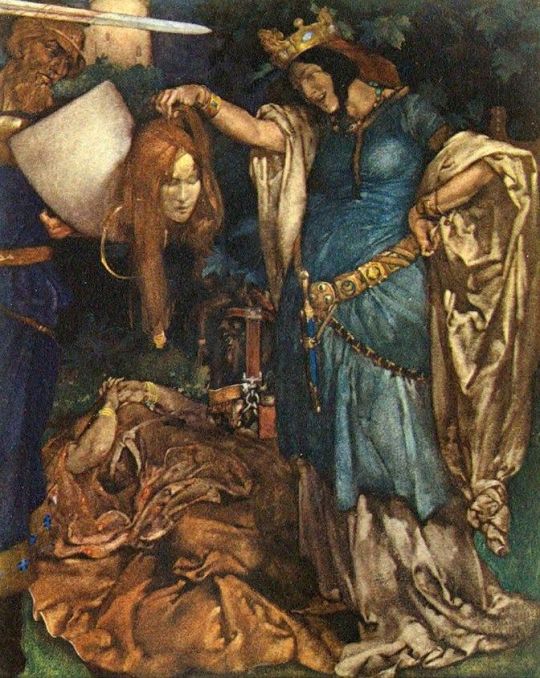
Annowre
Annowre (Anouwre) is an evil enchantress who desires King Arthur in Thomas Malory's Le Morte d' Arthur. Malory based her on a character from the earlier Prose Tristan, who was named as Elergia in the Italian La Tavola Ritonda.
As told by Thomas Malory, Lady Annowre was a great sorceress from North Wales (Norgalles), who fell in love with King Arthur and tried to seduce him when he came to Cardiff. But when she could not get Arthur to lie down and make love to her even by the means of magic, as he would remain faithful to Guinevere no matter what, she plotted his death.
Lady Annowre entices Arthur to her tower in the heart of the Perilous Forest (Forest Perilous), where every day he is forced to fight for his life. The Lady of the Lake, Nimue (Nineve, Nyneve, etc.), learns of this peril. She finds Tristan (Tristram) and brings him to the tower where they arrive just in time to see two knights defeat Arthur. As Annowre is about to decapitate the king using his own sword, Tristan rushes in and kills her knights. Nimue shouts to Arthur not to let Annowre escape, and the king chases down the sorceress and unceremoniously beheads her with the same sword (in some versions, it is Tristan who cuts her head off.. Nimue then hangs Annowre's head by the hair to her saddle as a symbol of victory
28 notes
·
View notes
Note
tristan/isolde/palomides your MIND
LISTEN I have so many thoughts about them!! It’s an actual tragedy that they’ve never inhabited a movie together. I first noticed them in Le Morte d'Arthur, as I'm sure most people did, as it's more accessible than the Prose Tristan. But I didn't really appreciate them until after I read Between Knights: Triangular Desire and Sir Palomides by Oldga Burakov Mongan. In this essay, Mongan claims:
Very often the bond between the desiring subject [Palomides] and his beloved [Isolde] is peripheral, subordinate in its intensity, to the subject's relationship with his male 'mediator of desire' [Tristan].
This essay breaks down many of the encounters between these three in Le Morte and demonstrates how interconnected they truly are. Speaking for myself, I prefer La Tavola Ritonda instead. I'm not quite done scanning that, but it will be on my blog ASAP.
In the mean time, it has one of my favorite Palomides introductions ever.
There entered on the side of the King of Scozia a knight who bore all black insignia, and who was called Palamidesso the Pagan, a son of King Scalabrino. This Palamidesso carried two swords by his side as a signal that no knight had ever made him bend over the saddlebow.
Duel wielding? Bend over the saddlebow, you say? Interesting. Palomides goes on to win this tournament! After that he follows his lord to another castle where he first sees Isolde, falls in love with her, and begins a hateful staring contest with Tristan (literally). It's here that they battle for the first time...
As Tristano looked over the field, he saw that Sir Palamidesso was leaving, and called out to him, "Hallo, knight, guard yourself against me! I am the knight you met at King Languis' court, and it seems now that I am the worthier of the love of Isotta the Blonde!"
Bold Palamidesso, hearing those words, turned his horse's head around and, drawing his sword, gave Tristano such blows on his helmet that he bent him over the saddlebow. But Tristano hit back, and hit Palamidesso so hard on his helmet that he made blood gush out of his mouth and nose, and knocked him off his horse so badly wounded that for a long time he was unconscious. Thus Palamidesso lost the prize, and lost also the right to wear two swords.
Compelling word choice throughout this. Anyway as per usual they continue to squabble until eventually settling their differences and becoming friends (in part thanks to Lancelot who apparently rents out his castle for polyamorous hookups).
"When I was jousting with Sir Lancilotto the other day, he said to me, 'Now, Palamidesso, Gioiosa Guardia is worth more than any other place in the world, for it holds a noble treasure.' Therefore I imagine that this treasure is Sir Tristan and the beautiful Isotta, because those two are the ones who excel all others in the world in beauty, prowess, and courtesy."
When he heard these words, Tristano allowed Palamidesso to remount and then let his lance fall, since Palamidesso had broken his. Then he spoke in this way: "Palamidesso, Palamidesso, here is this Tristano you have been searching for. Come and fight me, if you want to. If not, I am willing to stop because of those words you spoke. I am your enemy, but I am ready to make peace with you. Still, if it would please you to fight, I am ready to do battle with you. You may choose whichever pleases and delights you most."
Palamidesso replied, "Surely, Tristano, the man who could have you for a friend would be foolish to want you for an enemy, Therefore I ask that there be peace and good friendship between us."
Nobody tell Palomides that Lancelot was almost certainly referring to Guinevere and not Tristan or Isolde. But their truce culminates in everyone joining back up at Cuck Castle Joyous Guard.
The knights then rode in that direction, and when they arrived at the main palace they found the lady, Queen Isotta, all happy and joyous, attended by ladies and maidens. When Tristano told her how he and Palamidesso had made peace, she was very glad of it, and welcomed the knights with much honor. Then the tables were set out, and they all sat down to eat.
Much later, King Arthur hosts a joust in which all participants are to bring a lady. So, now that everyone are friends, Isolde is brought along with a retinue of knights, including Tristan and Palomides. They wear her colors and fight on "her" side against Arthur, Lancelot, and their kinsmen on Guinevere's "side." Polyamory enjoyers, this text is for us. Anyway the only portion of that I'll include is this sweet passage which really illustrates that the friendship in this little group is genuine. They're all affectionate after the truce and everyone is having a great time.
When Isotta had returned to the pavilion, the tables were set out and food was prepared, and when water had been brought out for their hands, they sat down to eat. As they ate, Gariette looked out and saw Palamidesso going by looking for them, and pointed him out to Sir Tristano. Tristano got up and went to meet him, taking him by the hand and leading him into the pavilion, where he disarmed and sat at the table. They all passed that night in great joy.
After this, they all live happily ever after, and nothing bad happens. :'^) I'll have La Tavola Ritonda done soon, and then you all can enjoy it too. I promise it's worth getting used to the Italian names, it's so fun! Thanks for the ask!
#arthurian legend#arthuriana#arthurian mythology#arthurian legends#arthurian literature#tristan#sir tristan#isolde#queen isolde#palomides#sir palomides#palamedes#sir palamedes#le morte d'arthur#sir thomas malory#la tavola ritonda#tristan and the round table#quotes#ask#anonymous
44 notes
·
View notes
Text


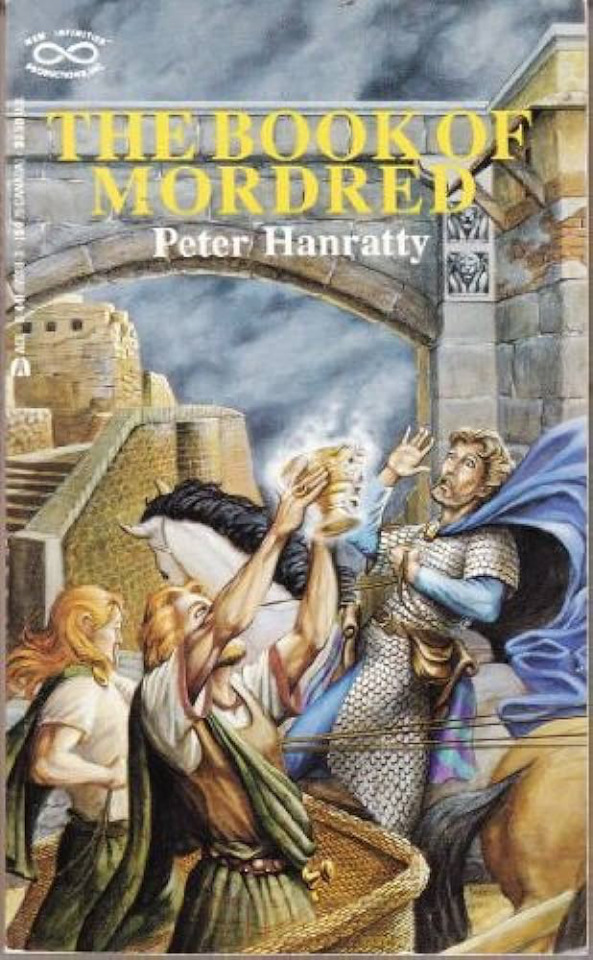
#arthurian legend#arthuriana#arthurian legends#arthurian mythology#arthurian literature#sir tristan#sir lancelot#sir mordred#la tavola ritonda#tristan and the round table#the queen’s knight#marvin borowsky#the book of mordred#peter hanratty#polls#my post
25 notes
·
View notes
Note
Hi, about the wives/lovers of Gawain masterlist.... There's a continuation /text inspired by the Tavola Rotonda, called Pulzella Gaia (roughly translated the Merry Maid), where Gawain marries a young lady who's a daughter of Morgan Le Fay & she's a sort of Melusine /female lindworm prince where she shifts from a serpent form to the one of a beautiful maiden. He's to keep his relationship secret for a while, till he almost got executed because of it, and Gaia appears in front of the court to save him. It's not well known unfortunately, but I think that it's a tale mentioned in some essays about the story of Melusine and its possible inspirations
Hi! I need to get my hands on this text it sounds so cool. I do remember that character in La Tavola Ritonda now I’m so curious. Where can I read this lindworm princess story…..anyone know?
#arthurian legend#arthurian legends#arthuriana#arthurian mythology#arthurian literature#la tavola ritonda#pulzella gaia#gawain#sir gawain#morgan Le Fay#ask#anonymous
12 notes
·
View notes
Note
oh oh… dinadan or la cote mal fet for the vulgate:)))
I’ve been attacked with brain worms
Bad news my friend, neither of these characters appear in the Vulgate! Might I interest you in some La Tavola Ritonda instead?

Name key:
Amorotto = Lamorak
Brunoro = Brunor
Daniello = Daniel
Dinadano = Dinadan
Lancilotto = Lancelot
Tristano = Tristan
Send me a character and I’ll reply with a Vulgate passage!
#arthurian legend#arthurian legends#arthuriana#arthurian mythology#arthurian literature#dinadan#sir dinadan#brunor#sir brunor#la cote male taile#knight of the ill-cut coat#la tavola ritonda#quotes#ask#i-dont-know134
12 notes
·
View notes
Text
Arthurian Trope Spotlight: Love will make you stronger
(and Queen Guinevere and the other ladies function like support buffs
Historia Regum Britanniae - A description of Arthur's Court

Knight of the Cart - Lancelot's Strength and Courage

[...]

Vulgate Cycle - Lady of the Lake's advice to young Lancelot

La Tavola Ritonda - Sir Viano's advice

****(Ouch. Tristan's father is a huge asshole here...)
Le Morte D'Arthur - Arthur commands Guenever to accompany him to war

This should put a perspective on a lot of things about Arthurian Literature, Chivalric Romance and Courtly Love: Love is objectively a force/element present in the World of Romance.
#tristan's dad is an asshole#queen guinevere#medieval ladies#arthurian ladies#courtly love#romantic ideals#historia regum britanniae#chretien de troyes#geoffrey of monmouth#knight of the cart#sir lancelot#vulgate cycle#tavola ritonda#la tavola ritonda#le morte d'arthur#king meliadus#prose tristan#king rivalen#king meliodas
5 notes
·
View notes
Note
This may be something I ought to dig for myself (if so, no worries) but do you know offhand if Tavola Ritonda or any other Italian Arthuriana gives specific Italian language variants for Kay’s Nicknames™️? Specifically for Gareth, re: Beaumains! I’ve been trying to figure out if there’s a common rendition for the very normal reason that I’ve fallen into the habit of scolding our cats (Sirs Beaumains, Gingalain, and Florence) in Italian, and it seems wrong not to TRY to be consistent…
Hi there! And hello to your kitties! Love their names. :^)
Not to go Full Nerd on you, but La Tavola Ritonda pre-dates Le Morte d'Arthur by 40ish years! So Gariette, as Gareth was called in Italian, had not yet been written into his kitchen boy role. Despite this, the translator, Anne Shaver, made some frustrating choices. In the introduction, she says:

Girl what are you talking about...First of all, the names in these examples are at least a little easier to decipher, "Lancilotto" is "Lancelot" and "Isotta" is "Isolde." But then Shaver goes and writes "Amorotto" drawing from the Prose Tristan "Amoral" when Malory used the Post Vulgate name for the character, "Lamorak," and that's how everyone knows him. On top of that, all place names are in Italian too, so "Ireland" is "Irlanda." This would be fine if she had at least been consistent. But no. We've got "Breus Sanza Pietá/Bruce sans Pité" because of Malory? It doesn't even match? Confusing is an understatement. That all said, Dinadan's brother Brunor still has his funny nickname! In La Tavola Ritonda, he isn't "Brunor La Cote Male Taille," as Malory had named him, but "Brunoro of the Ill-Fitting Coat." So he has an Italian first name and English nickname.
Unfortunately, this is the only Italian text I have, so I don't know if there are other nicknames in other stories. I'm nearly done scanning this, though, and then I'll share it. But I do have the Arthurian Name Dictionary by Christopher W. Bruce and the Arthurian Companion by Phyllis Ann Karr which are full of information that might help you find some nicknames for your kitty cats. As you can see, consistency is important to me as well as you. ;^) Good luck!
#arthurian legend#arthurian legends#arthuriana#arthurian mythology#la tavola ritonda#sir gareth#beaumains#sir gingalain#sir florence#ask#herbert-best
6 notes
·
View notes
Text
Today was good but I had weird spikes of anxiety so I just reread La Tavola Ritonda to cope lol
42 notes
·
View notes
Text

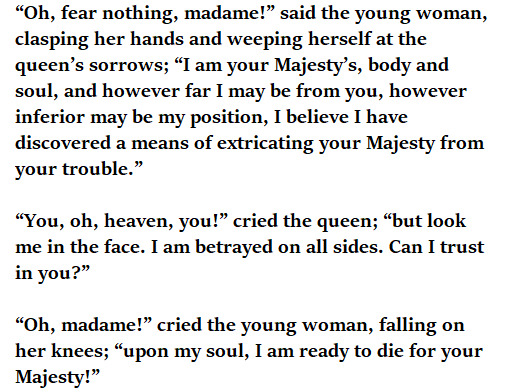
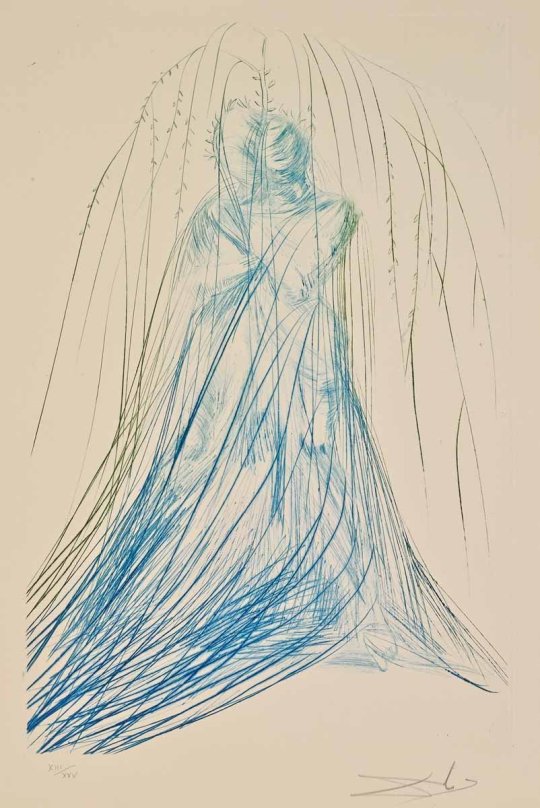



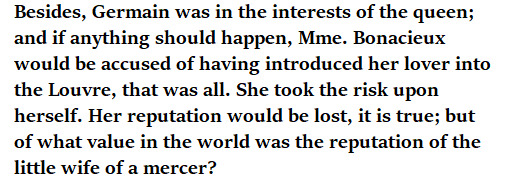
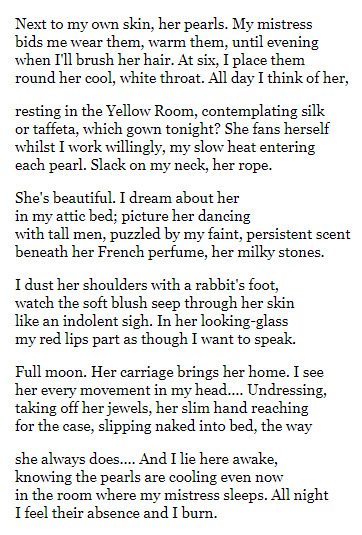


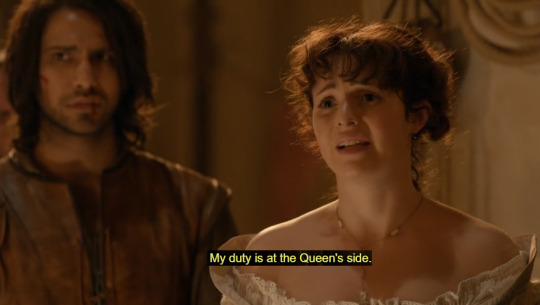
on Brangaine, Constance Bonacieux, and devotion
La Tavola Ritonda / The Three Musketeers by Alexandre Dumas / Iseult and Brangaine (1970) by Salvador Dalí / Tristan and Isolde discovered by King Mark (1883) by August Spiess (detail) / The Musketeers (2014-2016) / Prose Tristan / Warming Her Pearls by Carol Ann Duffy / Detail of the illustration for Richard Wagner's Tristan and Isolde in The Victrola Book of the Opera: Stories of One Hundred and Twenty Operas with Seven-Hundred Illustrations and Descriptions of Twelve-Hundred Victor Opera Records (1917) by Samuel Holland Rous
#'is the lesbian poem really necessary' yes it's a load-bearing lesbian poem.#arthuriana#arthurian legends#brangien#brangaine#isolde#iseult#the three musketeers#alexandre dumas#the musketeers bbc#the musketeers#constance bonacieux#anne of austria#my stuff#gella talks musketeers#gella talks arthuriana#talk talk talk#mine: compilation posts
85 notes
·
View notes
Text
Re: Misogynist Dinadan in La Tavola Ritonda…
I would say to read it before passing judgement.
Dinadan does give Isolde a hard time but he’s giving literally everyone a hard time the entire story. He’s very vocally against Breus raping women. He gives Bors a hard time for being chaste. He yells at Gareth for raping a girl and killing her father. He accuses Palomides of converting under peer pressure instead of actually wanting to. He calls Tristan on his stupid marriage to Isolde White Hands. He mocks his brother Brunor for being cringe. Dinadan is critical of everyone in the story to an extreme and in Isolde’s case it’s about adultery. It’s in the same vein as Lamorak sending the horn to court to prove all the women of Cornwall were unfaithful. Dinadan is just verbally savage to all who provoke him. I’m not going to say he isn’t a misogynist, he’s avidly against love throughout and that can be interpreted a number of ways, but I don’t think it’s something that dominates the character’s presence and didn’t diminish my overall enjoyment of the story. He still has a lot of tender love for Tristan and the rest of the friend group when he’s not in a rage about the way they tease him. They rile him up on purpose and laugh about it. So I think that context does reframe a lot of the character’s outbursts as well.
Just something to think about!
14 notes
·
View notes